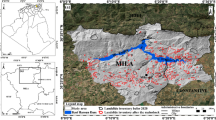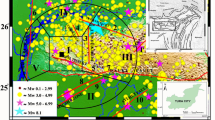Abstract
Landslides along active fault zones are important hazards during and after earthquakes. They can also cause secondary disasters such as surges, creation of landslide dams, and flooding, especially in reservoir areas. This study analyzed landslide susceptibility of the Xiangjiaba Reservoir area associated with the Yaziba Fault. Analysis of permanent displacement and failure probabilities were used for the regional assessment. Ground motion attenuation relations were selected and compared to produce a peak acceleration map using the Yaziba Fault as the seismic source. Geotechnical parameters were determined by classification of rock groups and geomorphic data were calculated using GIS tools. A distribution of the permanent displacements and a failure probability map was generated. According to the peak ground acceleration (PGA) map, the C-B model was adopted to present the actual conditions of PGA in greater detail while local specific models are more appropriate if there is little measured data. Results indicated larger displacement values and failures are distributed on both sides of the fault, especially in the hanging wall. The feasibility of the research approach was verified using historic earthquake-induced landslides.











Similar content being viewed by others

References
Abrahamson NA, Silva WJ, Kamai R (2014) Summary of the ASK14 ground motion relation for active crustal regions. Earthquake Spectra 30(3):913–914
Allen TI, Wald DJ (2009) On the use of high-resolution topographic data as a proxy for seismic site conditions (Vs30). Bull Seismol Soc Am 99:935–943
Ambraseys NN, Menu JM (1988) Earthquake-induced ground displacement. Earthq Eng Struct Dyn 16(7):985–1006
Bindi D, Pacor F, Luzi L et al (2011) Ground motion prediction equations derived from the Italian strong motion database. Bull Earthq Eng 9(6):1899–1920
Boore DM, Stewart JP, Seyhan E et al (2014) NGA-West2 equations for predicting PGA,PGV,and 5% damped PSA for shallow crustal earthquakes. Earthquake Spectra 30(3):1057–1085
Campbell KW, Bozorgnia Y (2014) NGA-West2 ground motion model for the average horizontal components of PGA,PGV,PGD,and 5% damped linear acceleration response spectra. Earthquake Spectra 30(3):1087–1115
Chen DS (1984) Empirical relations between the length of the earthquake surface rupture and the magnitude. North Chin Earthq Sci 2(2):26–32 (in Chinese)
Chiou B, Youngs RR (2014) Update of the Chiou and Youngs NGA ground motion model for average horizontal component of peak ground motion and response spectra. Earthquake Spectra 30(3):1117–1153
Cui YL (2015) Activity of Yaziba Fault and its disaster effects for landslides. Ph. D thesis, Sichuan University, Chengdu (in Chinese)
Del Gaudio V, Pierri P, Wasowski J (2003) An approach to time-probabilistic evaluation of seismically induced landslide hazard. Bull Seismol Soc Am 93(2):557–569
Dong RS, Ran HL, Gao Z (1993) The relationship between earthquake magnitude and length of active fault in China. Seismol Geol 4:395–400 (in Chinese)
Ge H, Chen QG, Wang DW (2013) The assessment and mapping of seismic landslide hazards: a case study of Yingxiu area, Sichuan Province. Geol China 40(2):644–652 (in Chinese)
Geng GS, Yu YX (2015) The empirical relationship between subsurface rupture length and earthquake magnitude in western China. Technol Earthq Disaster Prev 10(1):68–76 (in Chinese)
Han JL (2015) The identification of large-giant bedrock landslides triggered by earthquake in the Longmenshan Tectonic Belt. Acta Geol Sin Engl Ed 89(2):681–682
Hsieh SY, Lee CT (2011) Empirical estimation of the Newmark displacement from the arias intensity and critical acceleration. Eng Geol 4(4):34–42
Jibson RW (1993) Predicting earthquake-induced landslide displacements using Newmark’s sliding block analysis. Transp Res Rec 1411:9–17
Jibson RW (2007) Regression models for estimating coseismic landslide displacement. Eng Geol 91(2–4):209–218
Jibson RW, Michael JA (2009) Maps showing seismic landslide hazards in Anchorage, Alaska. U.S. Geological survey scientific investigations map 3077, scale 1: 25,000. http://pubs.usgs.gov/sim/3077
Jibson RW, Harp EL, Michael JA (2000) A method for producing digital probabilistic seismic landslide hazard maps. Eng Geol 58(S3–4):271–289
Kaklamanos J, Baise LG, Boore DM (2011) Estimating unknown input parameters when implementing the NGA ground-motion prediction equations in engineering practice. Earthquake Spectra 27(4):1219–1235
Khazai B, Sitar N (2000) Assessment of seismic slope stability using GIS modelling. Geogr Inf Sci 2(6):121–128
Li W, Huang RQ, Xu Q, Tang C (2013) Rapid susceptibility mapping of co-seismic landslides triggered by the 2013 Lushan earthquake using the regression model developed for the 2008 Wenchuan earthquake. J Mt Sci 10(5):699–715
Mankelow JM, Murphy W (1998) Using GIS in the probabilistic assessment of earthquake triggered landslide hazards. J Earthq Eng 2(4):593–623
Matsuoka M, Wakamatsu K, Fujimoto K et al (2005) Nationwide site amplification zoning using GIS-based Japan Engineering Geomorphologic Classification Map. 239–246
Miles SB, Ho CL (1999) Applications and issues of GIS as tool for civil engineering modeling. J Comput Civ Eng 13(3):144–152
Miles SB, Keefer DK (2000) Evaluation of seismic slope-performance models using a regional case study. Environ Eng Geosci 6(1):25–39
Motazedian D, Atkinson GM (2005) Stochastic finite-fault modeling based on a dynamic corner frequency. Bull Seismol Soc Am 95(3):995–1030
Newmark NM (1965) Effects of earthquakes on dams and embankments. Geotechnique 15(2):139–160
Papathanassiou G (2012) Estimating slope failure potential in an earthquake prone area: a case study at Skolis Mountain, NW Peloponnesus, Greece. Bull Eng Geol Environ 71:187–194
Refice A, Capolongo D (2002) Probabilistic modeling of uncertainties in earthquake-induced landslide hazard assessment. Comput Geosci 28:735–749
Rodriguez CE, Bommer J, Chandler RJ (1999) Earthquake-induced landslides 1980-1997. Soil Dyn Earthq Eng 18:325–346
Rodríguez-Peces MJ, García-Mayordomo J, Azañón JM, Jabaloy A (2014) GIS application for regional assessment of seismically induced slope failures in the sierra Nevada range, South Spain, along the Padul fault. Environ Earth Sci 72:2423–2435
Romeo R (2000) Seismically induced landslide displacements: a predictive model. Eng Geol 58(3):337–351
Sabetta F, Lucantoni A, Bungum H, Bommer JJ (2005) Sensitivity of PSHA results to ground motion prediction relations and logic-tree weights. Soil Dyn Earthq Eng 25:317–329
Sato HP, Hasegawa H, Fujiwara S, Iwahashi J (2007) Interpretation of landslide distribution triggered by the 2005 northern Pakistan earthquake using SPOT 5 imagery. Landslides 4(2):113–122
Saygili G, Rathje EM (2009) Probabilistically based seismic landslide hazard maps: an application in Southern California. Eng Geol 109:183–194
Scordilis EM (2006) Empirical global relations converting Ms and mb to moment magnitude. J Seismol 10(2):225–236
Shen JW, Qiu Y, Zhao ZH (1990) Rupture length magnitude relationship and fault-rupture model. Acta Geophys Sin 33(2):242–248 (in Chinese)
Slemmons DB (1982) Determination of design earthquake magnitudes for microzonation, 3rd International Earthquake Microzonation Conference Proceeding I of II: 119–130
Sokolov V, Bonjer KP, Wenzel F et al (2008) Ground-motion prediction equations for the intermediate depth Vrancea (Romania) earthquakes. Bull Earthq Eng 6(3):367–388
Su FH, Cui P, Zhang JQ, Xiang LZ (2010) Susceptibility assessment of landslides caused by the Wenchuan earthquake using a logistic regression model. J Mt Sci 7(3):234–245
Sun JH, Shuai XH (2011) Study on moderate-strong seismic intensity attention relations in Sichuan-Yunnan and its adjacent areas. J Earthq Eng Eng Vib 31(1):11–18 (in Chinese)
Tang HM, Jia HB, Hu XL, Li DW, Xiong CR (2010) Characteristics of landslides induced by the great Wenchuan earthquake. J Earth Sci 21(1):104–113
van Westen CJ, van Asch TW, Soeters R (2006) Landslide hazard and risk zonation—why is it still so difficult? Bull Eng Geol Environ 65:167–184
Varnes DJ (1984) Landslide hazard zonation: a review of principles and practice. UNESCO, Natural Hazards, No. 3
Wald DJ, Allen TI (2007) Topographic slope as a proxy for seismic site conditions and amplification. Bull Seismol Soc Am 97:1379–1395
Wang SY, Yu YX, Gao AJ, Yan XJ (2000) Development of attenuation relations for ground motion in China. Earthq Res China 16(2):99–106 (in Chinese)
Wang T, Wu SR, Shi JS, Xin P (2013) Application and validation of seismic landslide displacement analysis based on Newmark model: a case study in Wenchuan earthquake. Acta Geol Sin Engl Ed 87(z1):393–397
Wu SR, Shi JS, Wang HB (2012) Analysis of activity intensity for landslides triggered by the Wenchuan earthquake, Sichuan Province, China. Environ Earth Sci 65:1021–1028
Xu C (2013) Preliminary study on landslides triggered by the April 20, 2013 Lushan, Mw6.6 earthquake of China. Acta Geol Sin Engl Ed 87(z1):402
Xu Q, Zhang S, Li WL (2011) Spatial distribution of large-scale landslides induced by the 5.12 Wenchuan earthquake. J Mt Sci 8:246–260
Xu C, Xu XW, Dai FC, Xiao JZ, Tan XB, Yuan RM (2012a) Landslide hazard mapping using GIS and weight of evidence model in Qingshui River watershed of 2008 Wenchuan earthquake struck region. J Earth Sci 23(1):97–120
Xu GX, Yao LK, Li CH, Wang XF (2012b) Predictive models for permanent displacement of slopes based on recorded strong-motion data of Wenchuan earthquake. Chin J Geotech Eng 34(6):1131–1136 (in Chinese)
Yazdani A, Kowsari M (2013) Earthquake ground-motion prediction equations for northern Iran. Nat Hazards 69(3):1877–1894
Zeng Y, Anderson JG (1996) A composite source modelling of the 1994 Northridge earthquake using genetic algorithm. Bull Seismol Soc Am 86(1B):71–83
Zhang YS, Dong SW, Hou CT, Guo CB, Yao X, Li B (2013) Geohazards induced by the Lushan Ms7.0 earthquake in Sichuan Province, southwest China: typical examples, types and distributional characteristics. Acta Geol Sin Engl Ed 3(3):646–657
Zhou SH, Wang W, Chen GQ, Liu BC, Fang LG (2016) A combined weight of evidence and logistic regression method for susceptibility mapping of earthquake-induced landslides: a case study of the April 20, 2013 Lushan earthquake, China. Acta Geol Sin Engl Ed 90(2):511–524
Acknowledgements
This work is granted by NSFC international cooperation project (grant no. 41661134012) and the National Natural Science Foundation of China (grant no. 51509173).
We thank LetPub (www.letpub.com) for its linguistic assistance during the preparation of this manuscript.
Author information
Authors and Affiliations
Corresponding author
Rights and permissions
About this article
Cite this article
Liu, A., Zheng, L., Deng, J. et al. Landslide susceptibility of the Xiangjiaba Reservoir area associated with the Yaziba Fault. Bull Eng Geol Environ 77, 1–11 (2018). https://doi.org/10.1007/s10064-017-1053-0
Received:
Accepted:
Published:
Issue Date:
DOI: https://doi.org/10.1007/s10064-017-1053-0



